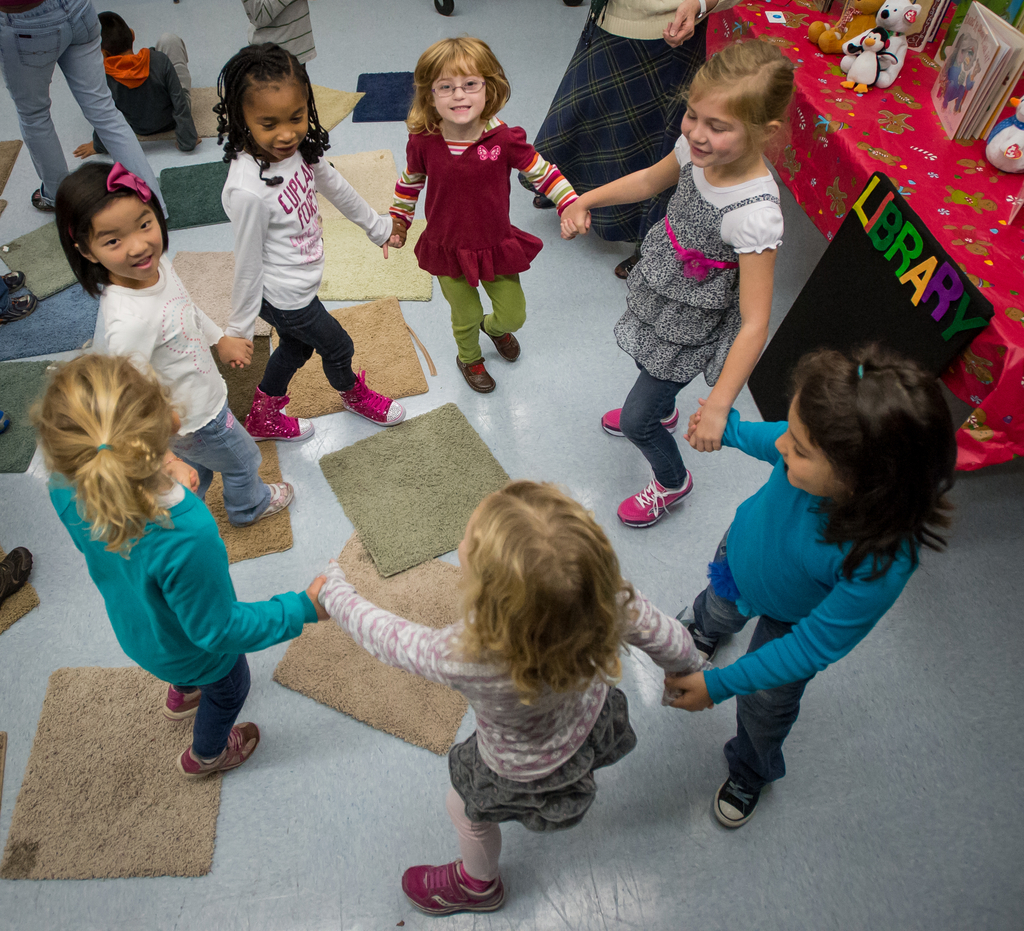5.4 Agents of Socialization

Learning Outcomes
By the end of this chapter, you’ll be able to:
- Learn the roles of families and peer groups in socialization.
- Understand how people are socialized through formal institutions like schools and workplaces, and through exposure to mass media.
Introduction
Socialization helps people learn to function successfully in their social worlds. How do people learn to use the objects of their society’s material culture? How do they come to adopt the beliefs, values, and norms that represent its nonmaterial culture? This learning takes place through interaction with various agents of socialization, like peer groups and families, plus both formal and informal social institutions.
Social Group Agents
Families, and later peer groups, often provide the first experiences of socialization. They communicate expectations and reinforce norms. People first learn to use the tangible objects of material culture in these settings, as well as being introduced to the beliefs and values of society.
Family
Family is the first agent of socialization. Mothers and fathers, siblings and grandparents, plus members of an extended family all teach a child what they need to know. For example, they show the child how to use objects (such as clothes, computers, eating utensils, books, bikes); how to relate to others (some as “family,” others as “friends,” still others as “strangers” or “teachers” or “neighbours”); and how the world works (what is “real” and what is “imagined”).
It is important to keep in mind, however, that families do not socialize children in a vacuum. Many social factors impact how a family raises its children. For example, students can use sociological imagination to recognize that individual behaviours are affected by the historical period in which they take place. Sixty years ago, it would not have been considered especially strict for a father to hit his son with a wooden stick or a belt if the child misbehaved, but today that same action might be considered child abuse.
Peer Groups

A peer group is made up of people who are not necessarily friends but who are similar in age and social status and who share interests. Peer group socialization begins in the earliest years, such as when kids on a playground teach younger children the norms about taking turns or the rules of a game or how to shoot a basket. As children grow into teenagers, this process continues. Peer groups are important to adolescents in a new way, as they begin to develop an identity separate from their parents and exert independence. This is often a period of parental-child conflict and rebellion as parental values come into conflict with those of youth peer groups. Peer groups provide their own opportunities for socialization since kids usually engage in different types of activities with their peers than they do with their families. Peer groups provide adolescents’ first major socialization experience outside the realm of their families. They are especially influential, therefore, with respect to preferences in music, style, clothing, etc., sharing common social activities, and learning to engage in romantic relationships. With peers, adolescents experiment with new experiences outside the control of parents: sexual relationships, drug and alcohol use, political stances, hair and clothing choices, and so forth. Interestingly, studies have shown that although friendships rank high in adolescents’ priorities, this is balanced by parental influence. Conflict between parents and teenagers is usually temporary, and in the end families exert more influence than peers over educational choices and political, social, and religious attitudes.
Institutional Agents
The social institutions of a culture also inform their processes of socialization. Formal institutions — like schools and workplaces — teach people how to behave in and navigate these systems. Other institutions, like the media, contribute to socialization by inundating people with messages about norms and expectations.
School

Most Canadian children spend about seven hours a day and 180 days a year in school, which makes it hard to deny the importance school has on their socialization. In elementary and junior high, compulsory education amounts to over 8,000 hours in the classroom (OECD, 2013). Students are not only in school to study math, reading, science, and other subjects — the manifest function of this system. Schools also serve a latent function in society by socializing children into behaviours like teamwork, following a schedule, and using textbooks.
School and classroom rituals, led by teachers serving as role models and leaders, regularly reinforce what society expects from children. Sociologists describe this aspect of schools as the hidden curriculum, the informal teaching done by schools. For example, in North America, schools have built a sense of competition into the way grades are awarded and the way teachers evaluate students. Students learn to evaluate themselves within a hierarchical system of A, B, C, etc. students (Bowles & Gintis, 1976). However, different lessons can be taught by different instructional techniques. When children participate in a relay race or a math contest, they learn that there are winners and losers in society. When children are required to work together on a project, they practice teamwork with other people in cooperative situations. Bowles and Gintis argue that the hidden curriculum prepares children for a life of conformity in the adult world. Children learn how to deal with bureaucracy, rules, expectations, to wait their turn, and to sit still for hours during the day. The latent functions of competition, teamwork, classroom discipline, time awareness, and dealing with bureaucracy are features of the hidden curriculum. Schools also socialize children by teaching them overtly about citizenship and nationalism.
The Workplace
Just as children spend much of their day at school, most Canadian adults at some point invest a significant amount of time at a place of employment. After school, the workplace is the next major institution of socialization that people encounter in their lives. Although socialized into their culture since birth, workers require new socialization into a workplace both in terms of material culture (such as how to operate the copy machine) and nonmaterial culture (such as whether it is okay to speak directly to the boss or how the refrigerator is shared).
Different jobs require different types of socialization. In the past, many people worked a single job until retirement. A study examining the work histories of Canadian works over a 30-year timeframe found that workers had on average 7 different employers” (Statistics Canada, 2021). This means that people must become socialized to, and socialized by, a variety of work environments.
One common feature of workplace socialization is learning time discipline and efficiency. At work, people are required to make continuous productive use of time and avoid idleness, and they are disciplined or fired if they do not. E.P. Thompson (1967) described the historical shift from a pre-industrial ‘task orientation’ in work to an industrial ‘time orientation’ in work. In pre-industrial societies the workday was organized according to the tasks that needed to be accomplished, with little attention paid to clock-time, whereas in industrial societies the workday is organized according to regulated, coordinated clock-time and the need to intensify productivity per unit of standardized time. This shift altered time sense from natural, irregular, cyclical and experientially comprehensible time, blurring work and leisure, to an artificial and abstract time sense based on the invention and implementation of mechanical clocks that sharply divided work and leisure and imposing an external synchronization of labour through timed work and concepts of efficiency. As Thompson points out, this imposition of clock-time on the labour process was not universally accepted by workers. It took place against resistance over a period of centuries, but gradually spread beyond the workplace to dominate society as a whole. The socialization effect of the modern workplace has to do with the internalization of clock-time along with a sense of urgency in getting tasks done within a specific, albeit artificial, time frame.
Mass Media
Mass media refers to the distribution of impersonal information to a wide audience via television, newspapers, radio, and the internet. With the average person spending over four hours a day in front of the TV (and children averaging even more screen time), media greatly influences social norms (Roberts, Foehr, & Rideout, 2005; Oliveira, 2013). In 2010, Statistics Canada found that 73 per cent said they watched 2 hours 52 minutes of television on a given day. Today, while adults watch approximately 20 hours of tv per week (or 2.8 hours per day), teens watched just 8 hours per week (Statistics Canada, 2013). This does not mean that Canadian youth are screen-avoiding. In fact, a high proportion of youth people between the ages of 15 and 24 spend more than 20 hours per week using the internet (42.3%), streaming videos (25.9%) or playing videogames (15%).
Intensity of Use of Internet, Video-Streaming Services and Video Gaming Services
Gender: Total, gender
Age group: 15 years and over
Level of education: highest cert, diploma or degree
Geography: Canada
| Using the Internet | Watching Streaming Video | Playing Video Games | |
|---|---|---|---|
| 2022 | 2022 | 2022 | |
| Proportion of users (%) | 98.2 | 98.4 | 72.7 |
| Proportion of users spending less than 10 hours per week (%) | 24.7 | 31.8 | 35.5 |
| Proportion of users spending 10 hours to less than 20 hours per week (%) | 32.1 | 38.6 | 20.3 |
| Proportion of users spending 20 hours or more per week (%) | 42.3 | 25.9 | 15.0 |
Through media, people learn about objects of material culture (like new technology, transportation, and consumer options), as well as nonmaterial culture—what is true (beliefs), what is important (values), and what is expected (norms). This can be beneficial as a way that people are socialized about the norms, expectations, and values of their society, but also harmful when media messages distort reality or present unrealistic images and expectations. As Dr. Haidt observes, our children’s heavy use of smartphones and online digital media has essentially ‘rewired childhood, triggering a host of mental health problems for young people. As Dr. Haidt (2024) observes, “we ended up overprotecting children in the real world while underprotecting them in the virtual world.”
Media Attributions
- Family Of Four Walking At The Street © Emma Bauso used under license courtesy of Pexels
- Chic Chick Clique © Udo Herzog is licensed under a CC BY (Attribution) license
- Thunder Hill Elementary School Kindergarten Tour © Howard County Library System is licensed under a CC BY-NC-ND (Attribution NonCommercial NoDerivatives) license

